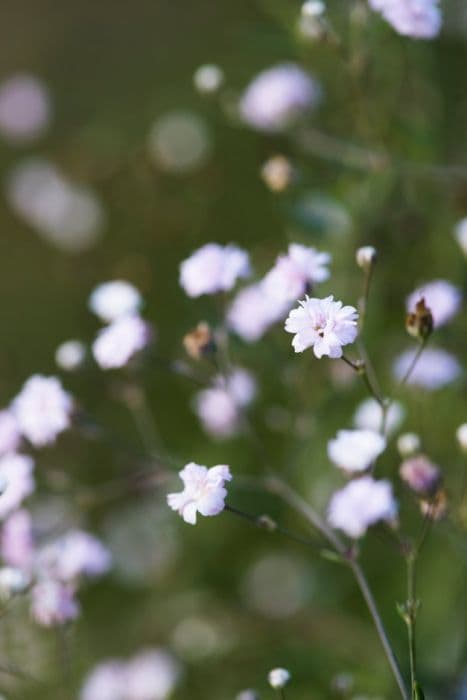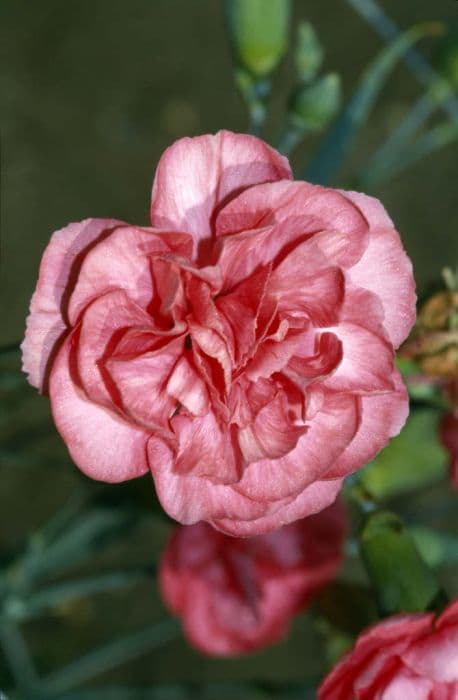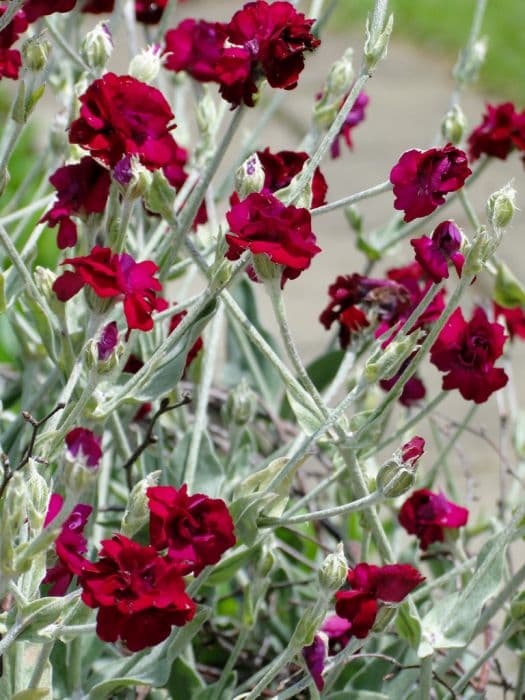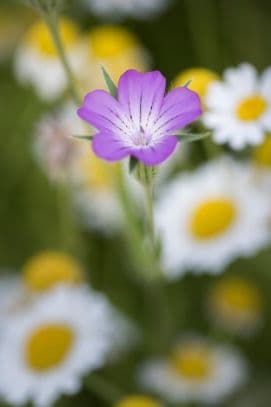Chickweed Stellaria media

ABOUT
The plant known as chickweed has a sprawling growth habit with slender, creeping stems that can root at the nodes. These stems bear pairs of small, oval-shaped leaves that are smooth and have a fresh, bright green appearance. The leaves are opposite each other and have a slightly pointed tip, appearing somewhat egg-shaped or elliptical. Along the stems, at the bases of the leaf pairs, delicate white flowers can be found. These dainty flowers typically have five deeply lobed petals, which can give the appearance of ten petals. The blossoms are usually less than a quarter-inch across, contributing to the plant's overall dainty and fragile look. The chickweed has a delicate and somewhat hairy appearance, with fine line-like hairs running along the length of the stems, setting off its tender green foliage and understated white flowers.
About this plant
 Names
NamesFamily
Caryophyllaceae.
Synonyms
Chickweed, Starweed, Mouse Ear, Satin Flower, Winterweed, Tongue Grass, Stitchwort, Adder's Mouth.
Common names
Alsine media, Arenaria vulgaris, Stellaria apetala, Stellaria bicolor, Stellaria media var. apetala, Stellaria media var. major, Stellaria neglecta, Stellaria pallida, Stellaria pubera.
 Toxicity
ToxicityTo humans
Chickweed, commonly known as Stellaria media, is generally considered safe for human consumption and is actually eaten as a leafy vegetable in many parts of the world. It has a long history in folk medicine, with various traditional applications. Chickweed is not considered to be a toxic plant to humans, and there are no commonly reported symptoms of poisoning from consuming it.
To pets
Chickweed, or Stellaria media, is also not toxic to pets such as dogs or cats. It is often considered a weed, but it does not pose a risk of poisoning if ingested by animals. There are no specific symptoms associated with chickweed ingestion since it is not poisonous to pets. However, it is always recommended that pet owners consult a veterinarian if they observe their pets eating large quantities of any non-food plants, as it may cause gastrointestinal upset or indicate a dietary imbalance.
 Characteristics
CharacteristicsLife cycle
Annuals
Foliage type
Deciduous
Color of leaves
Green
Flower color
White
Height
6 inches (15 cm)
Spread
1 foot (30 cm)
Plant type
Herb
Hardiness zones
5
Native area
Europe
Benefits
 General Benefits
General Benefits- Edible Use: Young leaves and shoots of Stellaria media, commonly known as chickweed, are edible and can be used in salads or cooked like spinach, providing a source of vitamins and minerals.
- Nutrient Rich: Chickweed is high in Vitamin C, calcium, magnesium, and potassium, contributing to a balanced diet.
- Animal Fodder: It can serve as a nutritious fodder for chickens, rabbits, and other livestock.
- Garden Companion: When used as a ground cover in gardens, chickweed can keep the soil moist and make nutrients more accessible for other plants.
- Natural Indicator Plant: Chickweed may indicate fertile soil, high in nitrogen, potassium, and phosphorus.
- Supports Biodiversity: The plant provides food for insects, such as bees, hence supporting local biodiversity.
 Medical Properties
Medical Properties- Anti-inflammatory: Stellaria media, commonly known as chickweed, has been used traditionally to soothe inflamed skin.
- Demulcent: The plant is thought to have soothing properties, forming a protective layer on mucous membranes.
- Emollient: Chickweed is often used in topical applications to soften and alleviate irritated skin conditions.
- Expectorant: It has been used to help ease the expulsion of phlegm from the respiratory tract.
- Diuretic: Chickweed is sometimes used to support increased urine production, aiding in detoxification and fluid balance.
- Laxative: Traditionally, it has been used in mild doses to relieve constipation.
- Mild Analgesic: The herb has been used to reduce minor pains and aches when applied topically or consumed.
- Antipruritic: Due to its potential anti-itch properties, chickweed may provide relief from itching associated with various skin conditions.
- Antioxidant: Chickweed contains antioxidants that can help protect against cellular damage.
- Nutritive: Chickweed is known for being rich in vitamins and minerals, and has been used to support overall nutrition.
 Air-purifying Qualities
Air-purifying QualitiesThis plant is not specifically known for air purifying qualities.
 Other Uses
Other Uses- Chickweed is used as a natural pest control in agriculture. It serves as a habitat for insects like hoverflies and lacewings, which are natural predators of pest species.
- When grown in crop rotations, chickweed can function as a cover crop, protecting the soil from erosion and helping to retain moisture during fallow periods.
- In poultry farming, chickweed can be included in chicken feed as a supplement. It provides essential nutrients and enhances the yolk color of eggs.
- This plant can be used as a live mulch in gardens. It grows quickly, suppressing weeds and thus reducing the need for chemical herbicides.
- Chickweed is considered a bioindicator of fertile soil since it prefers and thrives in nitrogen-rich environments, helping gardeners assess soil health without testing.
- Some artists and crafters use chickweed to create natural green dyes for coloring fabrics and other materials in an eco-friendly way.
- Chickweed may serve as an emergency food source in survival situations, given its widespread prevalence and edibility.
- In cold climates, chickweed is one of the few green plants that can be foraged for fresh greens during the winter months when little else is available.
- As a companion plant, chickweed attracts beneficial insects and provides ground cover, which can help protect more delicate plants from harsh weather.
- The stems and leaves of chickweed can be used in the making of compost tea, which is a nutrient-rich liquid fertilizer for plants.
Interesting Facts
 Feng Shui
Feng ShuiThe chickweed is not used in Feng Shui practice.
 Zodiac Sign Compitability
Zodiac Sign CompitabilityThe chickweed is not used in astrology practice.
 Plant Symbolism
Plant Symbolism- Resilience: Stellaria media, commonly known as common chickweed, is a hardy plant that can thrive in diverse conditions, symbolizing the ability to survive and flourish despite adversity.
- Innocence: The small, star-shaped flowers of common chickweed evoke a sense of purity and simplicity, often associated with the innocence of youth.
- Romance: In folklore, the common chickweed has been linked to love, with its delicate flowers representing the tenderness and sweetness of romantic feelings.
- Fertility: As a fast-growing and prolific plant, common chickweed can symbolize fertility and the capacity for abundant growth and reproduction.
- Healing: Historically, common chickweed has been used for medicinal purposes, symbolizing healing and the restoration of health.
 Water
WaterThe common chickweed (Stellaria media) prefers consistent moisture but does not do well with over-watering. Water chickweed when the top inch of soil feels dry to the touch, roughly about once a week, depending on the climate and soil drainage. Use a gentle water stream to avoid disturbing the plant's shallow roots, slowly soaking the soil around the base until it's moist but not saturated. In terms of volume, half a gallon per square foot every week should suffice, but always adjust depending on rainfall and temperature conditions.
 Light
LightCommon chickweed (Stellaria media) thrives in partial shade to full sunlight. An ideal spot for growing chickweed would be an area that receives morning sunlight and is protected from the intense afternoon sun, which can scorch the delicate leaves of the plant. Dappled sunlight underneath the canopy of larger plants or trees can also provide suitable lighting conditions for chickweed.
 Temperature
TemperatureCommon chickweed (Stellaria media) is a cool-season plant that grows best at temperatures between 50°F and 70°F. It can survive minimum temperatures down to around 20°F and can also tolerate a maximum temperature of about 80°F, though it may go dormant in the hotter summer months. Ideally, it prefers the cooler temperatures of spring and fall.
 Pruning
PruningPruning common chickweed (Stellaria media) is mainly for controlling its spread as it can become invasive. Trim back the chickweed to maintain its shape and prevent it from overtaking the garden. Early spring or fall, before or after the growing season, is the best time to prune chickweed. It does not require strict pruning schedules and can be pruned as needed or whenever the plant appears overgrown.
 Cleaning
CleaningAs needed
 Soil
SoilChickweed, or Stellaria media, thrives best in a well-draining, loamy soil that is rich in organic matter. The ideal soil pH for chickweed is neutral to slightly acidic, around 6.0 to 7.0. A good soil mix would consist of garden loam, compost, and perlite to ensure good drainage and fertility.
 Repotting
RepottingChickweed or Stellaria media does not typically require frequent repotting as it is often grown as an annual. If grown in containers, repotting every 1-2 years or when the plant outgrows its pot should suffice.
 Humidity & Misting
Humidity & MistingChickweed, or Stellaria media, is fairly adaptable and does not require high humidity. It grows well in average ambient humidity levels, making it suitable for most homes and gardens without the need for special humidity adjustments.
 Suitable locations
Suitable locationsIndoor
Plant chickweed in well-lit area, keep soil moist.
Outdoor
Place in partial shade, enrich soil, keep it moist.
Hardiness zone
3-10 USDA
 Life cycle
Life cycleStellaria media, commonly known as common chickweed, initiates its life cycle when seeds germinate, typically in cool, moist conditions often found in spring or fall. Seedlings emerge and rapidly grow into low-lying, mat-forming herbaceous plants with opposite, oval leaves and a sprawling habit. The plant quickly progresses to flowering, producing small white, star-shaped flowers with five deeply lobed petals, often appearing as ten. Chickweed is capable of self-pollination or can be pollinated by insects, leading to the production of fruit in the form of a small capsule containing numerous seeds. The seeds are dispersed by various means, such as water, animals, and human activity, allowing the plant to colonize new areas. Chickweed can complete several life cycles within a year, as it is an annual or occasionally perennial, and can persist through mild winters, regrowing in the spring to start the cycle anew.
 Propogation
PropogationPropogation time
Spring-Early Summer
Common Chickweed (Stellaria media) is most commonly propagated through its seeds. This plant tends to self-sow prolifically, so much so that it is often considered a weed. The best time to sow chickweed seeds directly is in early spring or fall, as cool temperatures assist with germination. The seeds require light to germinate, so they should be scattered on the surface of the soil or lightly covered with a thin layer of soil no more than 1/4 inch thick (around 6 millimeters). The soil should be kept moist but not waterlogged, and the seeds typically germinate within 7 to 14 days in cool conditions. Transplanting is not generally necessary because chickweed grows easily in place and spreads quickly once established.









